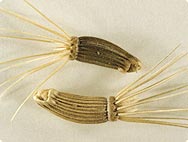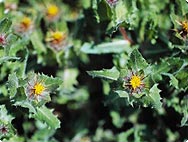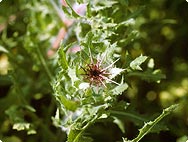A.Vogel search
When the internal search is activated, personal data such as your IP address is transmitted to our search engine Cludo. Data is thus transferred to a third country. Please click here if you want to display the internal search. You can find more information on data protection here: Privacy policy.
A.Vogel plant encyclopaedia
Cnicus benedictus L.
Blessed Thistle
History

Cnicus is derived from the Greek word knizein, which means ‘to torment’ and refers to the plant's thorns. The old nomenclature Carduus means ’thistle', under which family name the plant was formerly classified. The species name Benedictus is the subject of speculation. On the one hand, the meaning ‘blessed’ may refer to the healing powers of the plant while, on the other hand, it may refer to the Benedictine monks who used the plant in the Middle Ages to combat the plague. In the 17th century, Matthiolus wrote of the blessed thistle: ”...there is hardly a better medication for cancer and other rotting damage.” Cancerous growths on the outer body were washed with ’cardobenedictine‘ water and sprinkled with the crushed herb.
The ’Benedicta‘ described in old pharmaceutical works (for example St Hildegard's) is not Blessed Thistle, but herb bennet/avens (Geum urbanum L.).
Botanical characteristics

The thick tap-root ends in a basal rosette with lanceolate, serrated leaves, from which rises the 40 to 60 cm high, hairy, five-edged stem. The light green leaves are long and narrow, clutching the dull green stem, with prominent pale veins, the irregular teeth of the wavy margin ending in spines. The yellow flower heads sit apically in a calycle with pinnatifid thorns. The thorns are connected to each other by spiders-web-like hairs. The fruits (= achenes) are crowned by a conspicuous, distichous (in two rows) pappus.
The Blessed Thistle flowers from June to August.
Habitat

Blessed Thistle is native to the Mediterranean region and thrives especially on dry, sunny waste dumps and waste lands at elevations up to 1000 metres. The plant is cultivated north of the Alps but can also be found growing wild there.
Preparation

To produce the mother tincture, A.Vogel/Bioforce uses the fresh leaves and tips of the branches from organically grown plants when in bloom. The plant is harvested in July and August.
Blessed Thistle herb is used as an additive in bitter schnapps and herb liqueurs.